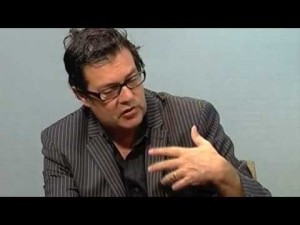When Doug Turkington, a UK psychiatrist, first announced to his colleagues that he wanted to help people with psychotic experiences by talking to them, he was told by some that this would just make them worse, and by others that this would be a risk to his own mental health, and would probably cause him to become psychotic! Fortunately, he didn’t believe either group, and in the following decades he went on to be a leading researcher and educator about talking to people within the method called CBT for psychosis.
I’m writing about Turkington because I just spent a week learning more about CBT from him at a training in California. This training was part of a bigger effort to bring this psychological approach into wider use in the western US. Attending this training and seeing the interest and passion in those who attended got me reflecting on what the role of CBT might be in changing our mental health system overall. A key question related to that, it seems to me, is the question of how CBT can improve its relationship to another key change effort in the field of psychosis, that of the Hearing Voices Movement (HVN).
I have a lot of interest in the possible improvement in that relationship between CBT and HVN, because for quite a while I have had my “feet in both worlds.” My first involvement with the mental health system was as an activist for change and increased choice, then I became a mental health professional so I could work to provide some of the alternatives I believed should exist. The first alternative approach to voices I heard about was the CBT approach of Paul Chadwick, so I started with that, and went on to become a CBT practitioner and educator. Then, when I heard about the HVN, I adopted many of its ideas as well, arranged for Ron Coleman to come to my town of Eugene Oregon to do some trainings, and got an HVN group going here.
While I have always interpreted CBT for psychosis in a flexible way, integrating it with HVN ideas, I have sometimes been unsure how well that would fit with the approach of the CBT for psychosis establishment. So it was really interesting to spend a week with Turkington, and to have a chance to explore his views in depth.
According to Turkington, the very most important part of cognitive therapy for psychosis is “normalizing” which means framing psychotic experiences as understandable and as just a fairly common variation of normal human experience and issues. This includes talking with people about how to get past fearing or “catastrophizing” such experiences, and even how to see them as possibly valuable, for example by seeing how such experiences can be part of a creative process or of a shamanic journey, etc. I have always been open to talking about this positive, somewhat shamanic side of psychotic experiences, and discussion of such views is common within HVN, but it was nice to see Turkington teaching this approach as part of standard CBT for psychosis!
Probably most of you recognize just how uncommon such views are within traditional psychiatry. Karl Jaspers for example stated that the psychotic symptoms of schizophrenia are “un-understandable: not reflecting a person’s personality or experiences.” Turkington mentioned that quote and others like it, and then confronted such views sharply, stating that “everything I know about psychosis tells me that such statements are delusional.” (In a previous MIA post, Olga Runciman faulted CBT for never confronting standard psychiatry. Turkington may not confront everything that needs to be confronted, but he definitely was willing to strongly critique many existing approaches, and I was amused and impressed by his story of how he measures progress in psychiatry in the US – that is, by the gradual reduction in booing he receives when he speaks about his ideas at the American Psychiatric Association!)
CBT has often been criticized for lacking an interest in people’s stories, but Turkington taught the opposite: that it is essential to hear people’s stories and to help people clarify them. He told a story himself about how he and his fellow professionals came to realize this was important. In some of the earlier research on CBT for psychosis, a control group was arranged of people who were supposed to receive only a “befriending” sort of therapy, where people could just chat about whatever they wanted. It turned out that many of the people in this control group chose to tell their stories, and these stories were typically about traumas that had happened to them. At the time, Turkington did not conceptualize psychosis as being particularly related to trauma, but this view quickly changed as a result of what was heard.
Turkington does still sees some psychosis, in particular those which start with a lot of “negative symptoms” and problems in thinking, and where “positive symptoms” develop only later, to be likely mostly genetic or biological rather than a result of trauma or life stress. I was skeptical of his conclusion about this, though he did present a fair amount of research indicating that there may be very different explanations for why some people become psychotic compared to others. The key thing I believe is that we continue to listen and learn, so we can really understand people’s stories even when they vary from our preconceptions, and such listening is very consistent with good CBT. It may be true that some people are more vulnerable or “sensitive” due to genetic or biological factors, but even in that case, they still may be able to learn to live well with that sensitivity, as when a person genetically vulnerable to sunburn learns how to protect themselves while continuing to be active outdoors, etc.
Developing a “formulation” or story of what has and is going on with a person’s experience and life situation is what Turkington described as the second most important part of CBT for psychosis. At times in the training, we focused on developing understandings of the story of what was going on “right now” with people – and this is what people more commonly think of as CBT – but at other times, the focus what clearly on understanding the bigger stories of how people’s experience and beliefs had emerged over time, in a meaningful way in response to life events.
The third most important component of CBT was described as being “reality testing.” This component is usually not emphasized as part of the HVN approach, and may even seem to clash with its “tolerance of all points of view” perspective. I find, though, that important elements of reality testing can be found in individual stories of HVN members. Eleanor Longden for example described starting to question the voices herself, then being told by the voices that she would either have to cut off a toe that evening, or they would come that night and kill her entire family. It was when she was able to stand up to this threat, and stand guard all night over her family instead (with a plastic fork, her only available “weapon”) that she was able to really demonstrate to herself that the voices were not actual beings outside of herself, but something more personal. This was a key event in her recovery.
Still, it’s easy to imagine “reality testing” being taken to mean the imposition of the therapist’s ideas about reality onto the client, and this is often believed to be the CBT approach. Turkington argued against this, and suggested it was impossible to do good work unless the therapist could keep an open mind about what might possibly be real. During the training, he shared stories of apparently supernatural and ghostly events that he had personally experienced, and emphasized that therapists should talk about such experiences with clients and with other therapists, in order to acknowledge our basic uncertainty about the nature of reality. At the same time, he described CBT as often being often helpful in getting people to notice the ways their experiences might be personal rather than part of the reality being experienced by others, so that they could deal with them more effectively.
In the film “Voices Matter“ and in an earlier MIA blog post, Rufus May suggested that we need to go beyond “just CBT” and appreciate the value of experiences like voices for their role as messengers about emotions and issues that need to be dealt with. I think Rufus is correct, but also, it seemed to me that Turkington was often saying the same thing in different words. Turkington talked about the importance of discovering people’s underlying affect, and then of helping them find ways to deal with it. He told stories of how working with psychotic experiences often led to disclosures of abuse or other kinds of key life issues, which could then be addressed in therapy.
And Turkington was happy to talk about approaches that went past standard CBT. He taught about integrating psychoanalytic approaches that see psychotic experiences as metaphors for emotional issues, a line of thinking that parallels the HVN understanding that the message of voices is often metaphorical. We discussed Compassion Focused Therapy which addresses people’s need for love an acceptance in a very direct way. And Turkington advocated for, and demonstrated, Voice Dialogue, a method that Rufus and others in the HVN have been teaching as a good way to explore and possibly change relationships with voices.
CBT practitioners have been critiqued in the past for being too slow to criticize things like forced treatment and excesses around medication. While Turkington was not perfect in my opinion on these issues, he was definitely willing to be critical of existing practices. A fair amount of time was spent talking about how forced treatment can induce trauma, creating future mental health problems. He pointed out how neuroleptics can shrink brains, and even identified a problem I hadn’t heard about, which involves atypical neuroleptics making command voices worse. He explained that what happens is that the atypcials block serotonin, but then such blockage can aggravate OCD like brain processes, and since command voices are OCD like, they can be increased by the drugs. He also shared the recent study on how CBT can be helpful for people who don’t want medications, and clearly advocated for choice in treatment options.
On the flip side, Turkington also talked about using CBT to get people to be more consistent with taking medications. Using psychological approaches to get people even more hooked on drugs that are likely to hurt them can be a terrible approach, but some of what Turkington was talking about didn’t seem to be entirely a bad idea – I think sometimes people have a better chance of getting off drugs if they take them consistently while learning skills and weaning down gradually, rather than bouncing on and off drugs in a chaotic manner. So while I think while CBT could be used in a destructive way to push for “compliance” it can also be used in better ways, as part of thoughtful decision making.
But, some of you might be asking, shouldn’t we aim to just liberate everyone from the mental health system, and get rid of all the professionals?
I would argue that while some may be ready to move away getting support from anyone who is paid to help them, many others are not, and so we continue to require some kind of paid or professional system to help these people. I believe we should be exploring a variety of options, from Open Dialogue to Soteria Houses, peer run respite, and CBT. One reason I am interested in CBT specifically is that it can be started with just a few individuals here and there, rather than waiting for a whole system to endorse a method like Open Dialogue.
But what about the key fact that HVN is an emancipatory approach, a social movement that aims to help people realize that experiences like hearing voices can be just a human variation, and in so doing aims to liberate people rather than to “treat” them? Does this mean there is a fundamental difference in aim between HVN and CBT?
In a blog post I mentioned previously, Olga faulted Alison Brabban, a CBT psychologist, for suggesting that HVN do research to show that its methods are effective in helping people. Why, Olga asks, should an emancipatory approach be asked to do research? Quoting her, “can you imagine women fighting for women’s rights saying yes to presenting models of emancipation to men so that they can be researched and tested to see if they work?”
Thinking about this question, I reflected on the role of research in social movements. Research can be really helpful in getting past social myths. As a participant in the movement toward LGBT rights, I’m very aware of the research of Evelyn Hooker, who demonstrated that gay people were on average just as happy and healthy as heteros, which shocked people at the time and helped to sharply question the psychiatric oppression of gay people. The research with voice hearers is quite different however – voice hearers on average tend to be psychologically troubled. So how can we interpret that, within an emancipatory framework?
HVN and CBT practitioners like Turkington agree that voices often emerge after distressing life events, and are signs of unresolved issues around those events. Then, depending on how the person relates to them, those voices can lead to further, more severe problems, or they can actually be helpful indicators and communicators about the nature of the underlying problem, that helps get it resolved. But people often need assistance in changing that relationship, so things can go in a good way. LGBT people can usually do fine if just left alone by “helpers” but voice hearers often need some kind of help to get to that good relationship.
So I think we need both the emancipatory approach, and sensitivity to the fact that many people are deeply distressed by voice hearing experiences and do need help, which won’t always be accomplished by voluntary networks. It is not surprising that those paying the bill for services provided will want to see evidence that the money will be spent effectively, so it is really important we have methods like CBT for psychosis that are both researched and progressive and humanistic.
At the same time, I think it is essential that people continue to organize outside of any professional community, challenging that community with the kind of new ideas that groups like HVN and other peer communities are capable of developing. This is essential for expanding our ideas about the ways it is possible to be healthy, and of the very diverse ways people can go about finding the kind of life that will work for them.
So, how can approaches like CBT and HVN best work together? I would suggest ongoing dialogue and exchange of ideas about that, along with openness to appreciating the strengths and weaknesses of each. I think HVN groups, done entirely without professionals, are much more liberating (and also cheaper!) which makes them the best choice whenever they are sufficient to meet people’s needs. Professionals, including CBT professionals, should be asked to do what they can to support such groups and to widely refer people to them. But the HVN model doesn’t fit everyone, or address all the issues, and many people simply refuse to go to any kind of group. So I think it’s also going to be important to develop competent professional approaches like CBT. Friendly relations and integration between the CBT and HVN movements will help insure that we can provide the right kind of help, something that fits each person, to more of the people who might need it.
Note: The online conference, ”Therapy on the Wild Side – Depathologizing and Working with “Psychosis” and Extreme States of Consciousness“ which offers 6 CE credits for professionals, is still currently available. It touches a bit on CBT, has a lot more on methods developed in the HVN, like Voice Dialogue, and also approaches that come out of working with hypnosis and other voluntary altered states. In the future, I hope to arrange online education specifically in CBT for Psychosis. Click here if you want to be notified of when those trainings become available. And/or consider filling out this survey about what other kinds of online education about psychosis you might be interested in.





With Karen Taylor’s permission, I am reposting a conversation between her and I that started on facebook in regards to the post above. It touches on some very important issues. (For those of you who don’t know, Karen Taylor is very active in the hearing voices network and hearing voices training, and she is also the wife of Ron Coleman, who is even more active in that field.)
Karen Taylor: Hi Ron It may interest you to know, that most of the early CBT in psychosis learning was done by psychologists who regularly went to the manchester hearing voices groups when Ron C was there and took the self help techniques and turned them into a therapy. This is why there is similarities but also why there is animosity as lately there is a feeling that you have to be a psychologist to do this work with voice hearers which is bullshit as it originated as self help in the voices movement. People have always gently challenged each other over their belief systems the respect is in accepting the persons answer if they dont want to think about it from another view point, but most ideas are not fixed but fluid dependant on what is happening in the persons life. One researcher who used Ron’s working with voices book came to the conclusion that his workbook was based on CBT, in fact it was the other way around the book predates the CBT in psychosis papers, also voice dialoguing was a natural part of the hearing voices groups and something some voice hearers have always done. Keeping alive the history of the HVN movement is important and necessary to make sure it is not colonised and sanitised by professionals which is what has happened to every other consumer movement breakthrough. This is not to say that professionals who work in this way are not needed or wanted but that they must not own this stuff as their own work and then exclude self help and peers from using these techniques themselves.
Ron Unger: Hi Karen, Thanks for this important note, including the historical bit! I share your outrage at the idea of professionals taking ideas that come from places like hearing voices groups and then claiming them as their own and saying others shouldn’t try them! As far as what I heard in the Turkington training, he didn’t say much about where ideas he shared came from, and he also didn’t suggest anyone needed any particular training to try the various ideas, other than of course an understanding of the ideas and the methods themselves.
Karen Taylor: Psychologists like Richard Bentall & people like Doug Turkington will be the first to acknowledge how important the groups and voice hearers were to their learning, in person. Richard is a great supporter of HVN and Ron C has shared the platform with Doug at many events. It is the professionals who have read the CBT books and done some of the training who sometimes pontificate on who can and cannot then use these techniques. I remember Ron talking about being at a psychosocial intervention conference where a professional was talking on running hearing voices groups -and the training needed to run it-he didn’t know Ron C who got up to ask him if he would be able to run a hearing voices group -the guy said “have you done our training” to which Ron replied no he hadnt the person then went on to say no he wouldnt be able to do it, at which point Ron told him who he was and how many groups he had run with out training and why he was entitled to run a group -his lived experience . This is the danger as the spread of CBT grows peers will be told they dont have the skills to engage in this work.
Ron Unger: Thanks Karen, for the added information. I think you are right about the tendency of many professionals to want to claim that things can’t be done without professional training, even though they were started by people who didn’t have such training. I have seen this reaction for example when I taught about voice dialogue – some professionals in the class expressed a belief that only highly trained professionals should attempt such things, even though I let them know about how the method has been used successfully by non-professionals. I would say though that this isn’t really a CBT kind of perspective – one of the merits of CBT is that it is usually taught as something anyone can do, it is put in self help books and such, professionals may be trained in applying the methods and helping people with them but the ideal is that people learn to do any methods themselves and make the professional obsolete. Maybe one thing we need is a guide for how professionals can work cooperatively and without arrogance or “colonization and sanitization” of practices that come out of the consumer/self help movement.